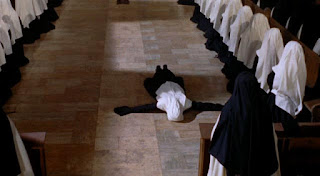It is about Gabrielle van der Mal, a Belgian woman who in 1930 decides to enter a convent and to try to become a nun. The process of being introduced into the life of the convent, of becoming a nun, is the focus of the first section of the film. The film begins with her saying goodbye to her siblings and then her father drives her to the convent. After they too have said goodbye she, together with several other young women, are taken through a door which is then locked behind them. They have now moved from a secular space to a religious space, a space which is almost treated as if it was a prison. From the closing of that door, which happens eleven minutes into the film, follows 35 minutes of all the procedures that a woman has to go through in order to become a nun. First they change clothes, then there is an introductory prayer and then the schooling begins. Learning how to be silent and use specific signs in order to communicate, learning obedience to the bell, how to write down imperfections, learning how to achieve complete detachment from their former life, learning how to walk, getting the hair cut, and moving from one set of clothes to another, as the women go from postulate to novice and from novice to nun. Finally, after several years, Gabrielle van der Mal has moved through all of these stages and is welcomed into the congregation and given her name as a nun, Sister Luke. Then the Reverend Mother tells her that ‘Tomorrow you will leave for the School of Tropical Medicine in Antwerp.’ and by that scene the first part of the film is over, around one third of the length of the film. (The second part is about her life as a nun, first in Belgium and then in the Congo, filmed on location and those locations include an actual leper colony.)
This first part, which is concentrated on procedure, is also to a large extent silent. There is hardly any dialogue, and the music come only in a few brief spurts. It is not completely impersonal; on a few occasions it is shown how Gabrielle fails to follow the rules. She might be late, or walk too fast, or being unwilling to leave a patient when the bell tolls, even though she must. So the interior struggle which is at core of the film is there from the start. But in this first part it is not the focus, it is the rituals themselves that are in focus.
This is also true for the very last sequence of the film, in which Sister Luke returns to being Gabrielle van der Mal. She has asked to be allowed to quit and permission has been granted. In the end she walks into a room with Reverend Mother and a representative from the Archbishop. She is asked to sign a document (three copies of it) and then she is to walk into an empty room where her old clothes are. She changes clothes, removes her religious symbols and insignia and then she rings a bell. A door opens and she walks out of the door and away. There is no music and the camera dispassionately observes as she walks further and further away from the door, moving from the religious space back into the secular. She eventually turns right, after a slight hesitation, and the words ‘The End’ appears. It is a sequence, and ending, of rare perfection; emotionally and artistically.
***
To return to the first part of the film; it was not in the book the film is based on, written by Kathryn Hulme and based on the experiences of a friend of hers (Robert Anderson wrote the fine script), and neither is it something that enhances the telling of the story (which on a basic level is about a woman who becomes a nun and then finds it is too difficult and quits). Yet it is exactly this section, and later, similar ones, that makes the film what it is, and is what specifically signals that it is a film directed by Zinnemann. Gabrielle van der Mal has to make a profound decision, whether to be true to her conscience or to remain where she is and not cause any trouble, so that recurring theme of Zinnemann is present, but it is the style of which the film is told that is most explicitly Zinnemannian. The long sequence on the procedure by which one becomes a nun, before Sister Luke’s interior battle begins, is not for the sake of storytelling but for the sake of an investigation into the heart of the convent, and the rituals that the nuns perform. This is a key aspect of Zinnemann's art, wanting to know, and wanting to show, how something is done. It forms a link to his early documentaries. But the film could also be discussed as transcendental, in Paul Schrader's sense.
The Nun’s Story is the first film that is made in Zinnemann’s late style, in which the narrative moves slowly and is interspersed with contemplative images of trees, statues, clouds and such. That is a change from the more brisk and efficient style of storytelling that Zinnemann used earlier, but which had begun to loosen up over time. The Nun’s Story is 150 minutes, longer than any of his earlier films except Oklahoma! (1955), a musical which do not really count here as it is so different in many ways. These later films are longer and slower but not because they contain more information or events but because they are told in a different style, more contemplative; a style which from now on would be his usual one. This stage in Zinnemann's oeuvre is rarely discussed but it is one of the great treasures of world cinema.



